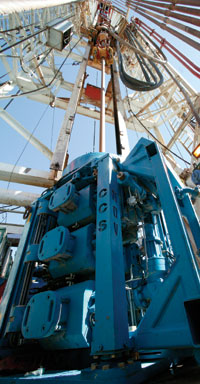|
Vol. 226 No. 12 |
| |
 |
Rig Floor Equipment
Continuous circulation system goes into operation
The first Continuous Circulation System (CCS) has successfully completed two separate drilling operations in Italy and offshore Egypt for Eni S.p.A. The CCS, winner of World Oil’s 2004 “New Horizon Award,” was introduced for commercial operations at the 2005 Offshore Technology Conference. To date, the system has been used to maintain uninterrupted downhole circulation during some 600 connections for both drilling and tripping operations.
 |
Based on the successful completion of the Italian test, Eni immediately made plans to use the CCS on a challenging well offshore Egypt.
|
|
This new technology was developed by National Oilwell Varco subsidiary, Shaffer, in a joint industry project with participation by BP, British Gas, Eni S.p.A., Statoil, Shell and Total. The CCS combines three Ram BOPs with an iron roughneck-like component and integral drill pipe slips to make connections with jointed pipe while maintaining circulation. The system employs fiber optics for inter-tool communication and a touch screen graphical user interface for operator control. The CCS eliminates turning off the pumps to keep a constant bottom-hole pressure during connections with jointed pipe. This facilitates drilling wells with a narrow pore pressure/ frac pressure window that can make drilling difficult or impractical with conventional techniques. The CSS also reduces stuck pipe incidents. Continuous circulation mitigates wellbore ballooning effects and the likelihood of taking unexpected oil and gas influxes. Cuttings transport and removal are also improved.
The first commercial use of the system occurred on a land rig drilling for Eni in Val d’Agri field in southern Italy. The purpose was for Eni to evaluate the CCS and familiarize its personnel with the system’s operation and capabilities in a friendly, relatively benign drilling operation. The Monte Enoc 10 well was selected, since the location was readily accessible and the drilling program did not involve any difficult formations. The CCS was utilized to drill a 660-m section of 12-1/4-in. hole with 5-in. drill pipe. This was the first time that the CCS was used to handle drill pipe stands and the first use of the completed production control system software. In previous tests, only single joints of drill pipe were handled. The system made 82 connections – 20 while drilling ahead and 62 connections, while tripping (circulating into and out of the hole).
The system performed well throughout this test and achieved total connection times of 18-20 minutes. Total connection time is the sum of the mechanical connection time, pipe handling time and the time lost when stopping and re-establishing circulation. With the CCS, mechanical connection time takes longer than with conventional connections, due to the many steps required to switch the flowpaths within the pressure chambers, but total connection time is reduced, because the mud pumps are never stopped. With the lessons learned from this test, improvements were made to the tool’s communication system and rig-up/ rig-down procedures were optimized (the system is not normally used while tripping within the casing).
Based on the successful completion of the Italian test, Eni immediately made plans to use the CCS on a challenging well offshore Egypt. The section of hole re-entered and drilled with the CCS was at a depth exceeding 5,000 m, with a pore pressure over 2.0 sg, and an extremely narrow pore pressure/ frac gradient window of 0.03 when exiting the casing shoe. Drilling problems including kicks, connection gas, lost circulation and ballooning effects, thwarted previous attempts to drill to target depth and caused significant amounts of non-productive time. This resulted in the well being temporarily plugged and abandoned. Continuous circulation and resulting constant downhole pressure allowed the re-entry to be drilled with a mud weight less than the pore pressure, yet with an equivalent circulating density greater than the pore pressure. This overcame the drilling difficulties encountered in the first attempt to drill the zone. With the CCS in place, the well has now been drilled past its original TD with over 500 connections (drilling and tripping) made, while continuing to circulate. Connection times continue to improve, and experience with the tool has led to reduced rig-up and rig-down times. More importantly, drilling with continuous circulation has allowed the well to be drilled to the target depth, developing reserves that were previously inaccessible.
The performance and reliability of the CCS during its first usage has been spectacular. In almost five months of operation, there has been only one unplanned interruption of circulation charged against the CCS. This interruption was less than three minutes and was due to operator error. Additionally, in its first commercial operation, the CCS has accumulated non-productive time less than 1% of total project hours.
Eni plans to continue to use the Continuous Circulation System in Egypt and will begin to incorporate its use in several of their other drilling areas. A second CCS unit is already on location in Norway and a third unit, slated for use in the Gulf of Mexico, is in the final stages of manufacture. 
|




